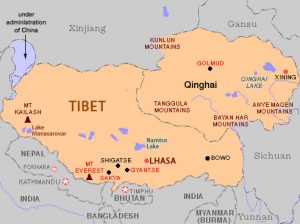 The first Kailash Mansarovar pilgrims of the year have crossed into Tibet through the 16,500-foot high Lipulekh pass in Uttarkhand. Pilgrimages will take place between June and September during which time 1,430 devotees are expected to visit one of the holiest sites in the Buddhist, Hindu, Jain and Bon religions. Buddhist and Hindu pilgrims will circumambulate the 22,000-foot high Mount Kailash in a clockwise direction; Bon and Jain pilgrims will proceed anti-clockwise. The distance around the mountain is 52 kilometres. The high altitude and distance make the pilgrimage an extreme physical challenge.
The first Kailash Mansarovar pilgrims of the year have crossed into Tibet through the 16,500-foot high Lipulekh pass in Uttarkhand. Pilgrimages will take place between June and September during which time 1,430 devotees are expected to visit one of the holiest sites in the Buddhist, Hindu, Jain and Bon religions. Buddhist and Hindu pilgrims will circumambulate the 22,000-foot high Mount Kailash in a clockwise direction; Bon and Jain pilgrims will proceed anti-clockwise. The distance around the mountain is 52 kilometres. The high altitude and distance make the pilgrimage an extreme physical challenge.
Some scholars consider Mount Kailash to be the site traditionally identified as Mount Yung-drung Gu-tzeg where Tonpa Shenrab, the founder of the Bon religion, was born. The Bon tradition speaks of a spiritual realm called Tagzig Olmo Lung Ring, a non-dualist realm that exists outside of time where peace and enjoyment are the materials that people are made of. A pyramidal mountain lies at the centre of Tagzig, ascending to the sky like a staircase from which four rivers flow into waterfalls, each one representing an archetype of the forms of thought: the snow lion, the horse, the rooster and the elephant. Those four rivers are today known as the Indus, the Brahmaputra, the Sutlej and the Karnali (a tributary of the Ganges).
According to legends Kailash was the location of an epic showdown between the Buddhist sage Milarepa and the Bon shaman Naro Bon Chung. Bon Chung found Milarepa meditating on the shores of Lake Mansarovar and challenged him, demanding that he follow the Bon teachings if he wished to stay at the site of the Holy Mountain. A contest to see whose miraculous powers were greater followed. Bon Chung straddled the entire lake with one leg on each shore in an impressive opening move, but Milarepa trumped him by picking up the entire lake and placing it on the tip of his finger. In the deciding challenge, Milarepa and Bon Chung raced each other to the summit of the mountain. Bon Chung set off quickly on his shamanistic drum, a popular form of transport for demi-gods in those times. As Bon Chung flew towards the summit, Milarepa slept before being woken by his alarmed disciples. Milarepa assured his followers that there was no need to worry before casting a spell on Bon Chung, halting his progress. Milarepa then snapped his fingers and reached the summit in an instant. Milarepa’s victory had the effect of displacing Bon and establishing Buddhism as the primary religion in Tibet.
 Tibetan Buddhists know Kailash as “Kang Rimpoche” and consider it to be the abode of a tantric deity called Demchog and his companion Dorje Phamo. Demchog is an exotic colourful and energetic character. He is depicted as having four three-eyed faces of different colour, twelve arms and hands carrying significant objects, and he wears a crown of human skulls and a tiger skin cloth around his waist. Dorje Phamo is usually straddling Demchog in the yab-yum position in thangkas – representing the two.
Tibetan Buddhists know Kailash as “Kang Rimpoche” and consider it to be the abode of a tantric deity called Demchog and his companion Dorje Phamo. Demchog is an exotic colourful and energetic character. He is depicted as having four three-eyed faces of different colour, twelve arms and hands carrying significant objects, and he wears a crown of human skulls and a tiger skin cloth around his waist. Dorje Phamo is usually straddling Demchog in the yab-yum position in thangkas – representing the two.
Hindus consider Kailash to be the abode of Lord Shiva. Shiva wears the bones of the dead as a decoration and smears himself in ash, signifying the burning of the lower desires. He has cut asunder the bonds of ego and liberated his inner essence from the darkness of ignorance. Atop Kailash, Shiva sits in meditation alongside his consort Parvati. They practise asanas together, make love and smoke a lot of chillum. A character of great contradictions, Shiva is at once the Lord of Yoga and the ultimate ascetic, yet he is also considered the divine master of Tantra, the esoteric science that regards sexual union as the perfect path to enlightenment. Hindus make the pilgrimage to Kailash to have the darshan (divine view) of Shiva’s residence and to be released from the clutches of delusion.
In Jainism Kailash is known as Ashtapada. It is thought to be the place where the first Jain Tirthankara, Rishbahdeva, attained Nirvana. Upon his death on Kailash Rishbahdeva’s karma was destroyed and he was liberated from the cycle of death and rebirth. Jains are renowned for being strict ascetics who strongly renounce the material world. The Jain doctrine of Anekantavada states that truth and reality are complex and always have multiple aspects. In the Jain tradition questions should not be answered with a “yes” or a “no” but simply with the word “possibly” because reality cannot be fully expressed by language.




 Print
Print Email
Email